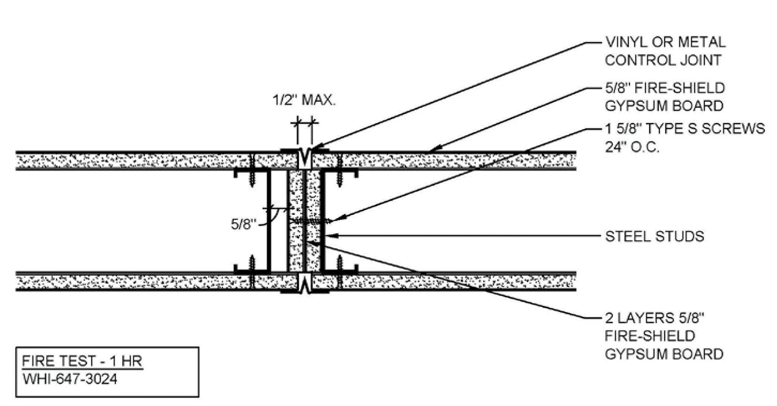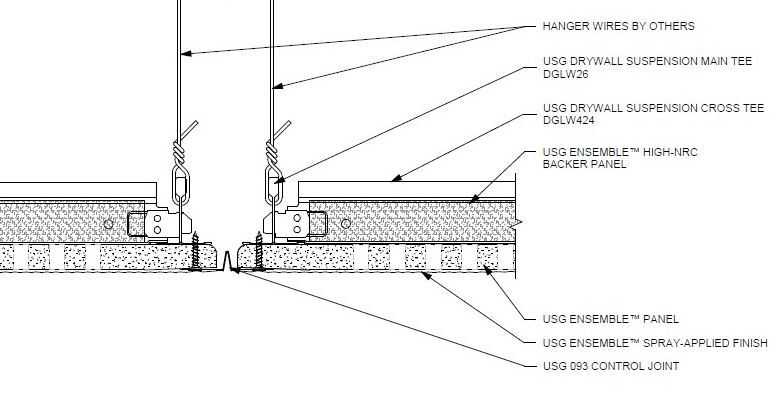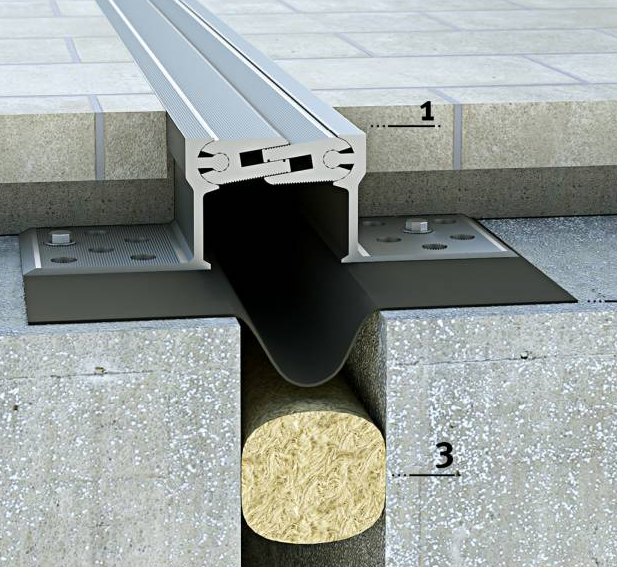If you’ve only worked in residential construction, there’s a chance you’re not all that familiar with drywall control joints. Control joints may be more familiar in reference to other building materials like concrete, in which gaps are inserted to control movement caused by forces like temperature or humidity that could lead to cracking.
Drywall control joints work in the same capacity but for finished gypsum board walls and ceilings. These small gaps at certain junctions between gypsum panels are fixed together by specific beads or flanges that let the sheetrock expand or contract as necessary without unsightly or unsafe cracking in the finished drywall.
In general, drywall control joints are most commonly used in commercial construction projects that involve long stretches of uninterrupted, continuous drywall typically found in office buildings, hospitals, and schools. But control joints are used in a variety of building types.
Drywall Control Joint Requirements
The Gypsum Association specifies several precise drywall control joint requirements.
The technical documents GA-216-2021 and GA-234 by the Gypsum Association and ASTM C840 by the American Society for Testing and Materials provide the standard specification for installing control joints.
The Purpose of Control Joints in Drywall
Control joints are planned spaces, or joints, placed between adjacent surfaces in walls and ceilings to minimize cracking and stress caused by expansion and contraction of gypsum board.
Though contractors and architects often overlook them, drywall control joints are necessary to include in your design plan and execution.

Why Do We Need Control Joints in Drywall?
Control joints are necessary for drywall to temper the internal expansion and contraction stresses. Gypsum board can expand and contract according to surrounding temperature and relative humidity.
If the temperature in an area increases by 50 degrees, a 100ft plane of drywall would expand by over ½”. A gypsum board wall 300 ft long would see an expansion of over 1” if the relative humidity were to change from 10% to 50%.
If control joints are overlooked or not installed properly, drywall expands and leads to cracking.
While drywall cracking cannot be entirely avoided, control joints protect gypsum board from cracking due to normal movement expected during the lifetime of a building.
Where Are Drywall Control Joints Needed?
Most manufacturers and standard specifications share the same installation points for control joints.
- Walls: Control joints should be installed in walls or partitions that run in an uninterrupted, straight plane exceeding 30 feet. USG recommends if there is perimeter relief, you can space up to 50 feet.
- Ceilings: In interior ceilings, control joints should be installed in intervals of 30 feet, extended to 50 feet if the interior ceiling has perimeter relief. If specific stress points occur at intervals of less than 30 feet in these internal ceilings, the control joints may be installed at a lesser interval. Control joints should follow the same 30-foot interval rule in exterior ceilings and soffits.
- Where specified: The architect should identify other control joint installation points on building plans. These spots may include where partitions, walls, or ceilings traverse a construction joint, where ceiling framing members change direction, intersections of rectangular areas, etc.
Types of Drywall Control Joints
Control joints can take several different forms.
Because they are, by definition, a predetermined space set into long, linear expanses of gypsum panels, they can be an open gap. However, leaving a gap between sheetrock joints isn’t cosmetically appealing and would require covering with trim and a lot of joint compound.
More likely, control joint products made by companies like Trim-Tex provide aesthetically pleasing and finished edges while allowing drywall seams to expand and contract.
These products have a variety of names, but they typically come in either metal or PVC vinyl material.
Which type of control joint material you use, much like what material your studs and joists are made of, doesn’t make much difference for application. Just be sure to follow specifications and architectural design.
How to Install Drywall Control Joints in Gypsum Partitions
Installing drywall control joints was pretty tricky. In earlier days, the only way to properly install a control joint involved installing 2 or 3 rips of drywall on the interior webbing of back-to-back wall studs.
This provided the room necessary to control thermal expansion and prevent drywall cracking, but once drywall was installed, sanded, and finished on the exterior face of the studs, there was no way to see if the control joint was installed correctly.
Nowadays, control joints in metal or vinyl material can be installed handily. Leave a gap between gypsum panels and install the control joint product (which typically look like a small v) between them.
The joint can be glued, stapled in place, or embedded with joint compound, much like drywall corner bead. Once installed, some have a tear-off strip that keeps the control joint clear of the setting compound, ensuring it has enough space to function correctly.
Check your control joint manufacturer’s installation instructions just as you’d check the Gypsum Association and ASTM technical documents for control joint requirements.
While a misplaced drywall control joint likely won’t cause any structural damage, drywall cracking can range from a minor cosmetic problem to an insulation and fire safety hazard, the burden of which will likely fall on the drywall contractor.
Drywall Control Joints in Rated Partitions
When control joints are installed in rated partitions, they must be parallel and adjacent to the framing materials on each side of the gap. Assemblies are rated to contain a fire, should one break out, for an allotted time.
Modern fire-rated control joints will close the gap between gypsum panels to prevent airflow from feeding and spreading the fire.
Because of this, the drywall control joint in rated partitions should be installed so that the gypsum board strips are continuous.

Drywall Ceiling Control Joints
Drywall control joints at ceilings are needed in 30-foot intervals or less. The control joint must extend the entire ceiling width from wall to wall.
Of course, drywall ceiling control joints can be required at locations less than 30 feet apart, depending on the architect’s design.
Always ask for clarification on the exact location of drywall control joints in ceilings before hanging or beginning the drywall finishing process. And be sure to have control joint submittals and product data approved by the architect before installation.

What’s the Difference Between a Drywall Control Joint and Drywall Expansion Joint
Drywall control joints are predetermined gaps in gypsum panels that help control drywall movement and minimize cracking in the finished material.
Building expansion control joints, which can also be called construction joints, are also predetermined gaps placed instead in building materials like concrete, block walls, exterior sheathing, and even acoustical ceilings.
Building expansion joints are designed to reduce the effects of movement caused by temperature fluctuation, live loads, settling, wind, seismic activity, etc., on building materials.
Building expansion joints also differ from drywall control joints because they extend through the entire building envelope, from interior wall to the exterior wall. The purpose of a building expansion joint is to allow for deflection or slight building movement, so it must provide relief through the entire wall and ceiling systems.

Building expansion joints are filled with caulk on the exterior to prevent moisture and insects from entering the building.
Because both terms describe predetermined gaps in some form of building material and serve similar functions, they’re often used interchangeably when discussing sheetrock installation.
It can be confusing, mainly since control joints can also refer to gaps in concrete or other material to prevent cracking. It’s always important to specify the exact type and location of the control joint.
Control Joints for Beginners or DIYers
If it’s your first time working with control joints on a commercial project, consult the plans and specifications for location and the exact type of control joint.
Submit product data to the architect for approval, and don’t order material before submittals are returned as approved.
Submit shop drawings showing where you propose to install control joints on wall elevations and reflected ceiling plans. Don’t install drywall until your shop drawings and submittals are returned and approved.
For the homeowner wondering if control joints will help reduce drywall cracking, consult your home builder and ask about possible building stress points or locations where control joints make sense in your new home.
Control Joint Resources – USG Handbook



